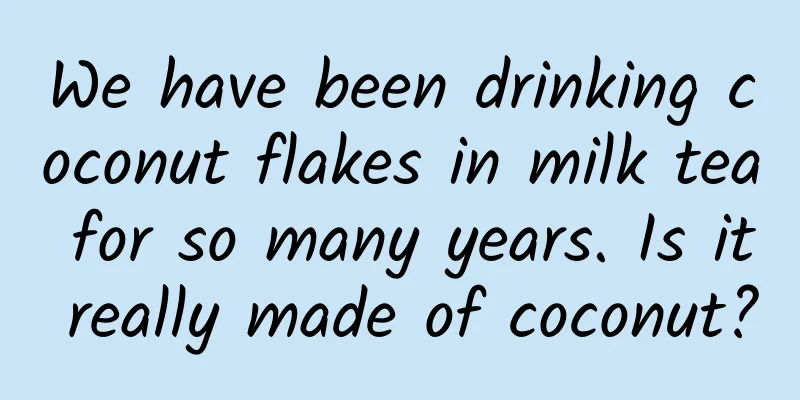We have been drinking coconut flakes in milk tea for so many years. Is it really made of coconut?

|
If you love milk tea, you must be familiar with the condiment "coconut nut". Coconut flakes are white and look very much like coconut meat. The word "coconut" is also in its name. When drinking milk tea, have you ever wondered what the relationship is between it and coconut? I can't tell the difference between coconut fruit and coconut meat As we all know, coconut is the fruit of the tree of the genus Cocos in the palm family. It is spherical, and its outer shell consists of three layers: exocarp, mesocarp and endocarp. Among them, the exocarp is a thin and smooth cortex, the mesocarp is highly fibrous, showing the common "hairy coconut" form, and the endocarp is a lignified brown hard shell. Usually, the part of coconut that we eat is its coconut milk, which comes in two forms: solid and liquid. Solid coconut milk is attached to the endocarp, which is very similar to coconut fruit. It is what we often call coconut meat, which can be made into products such as coconut flakes and coconut oil. Liquid coconut milk is what is often called "coconut water", which is located in the cavity inside the coconut, and is transparent and slightly whitish. The national drink "Coconut Tree Brand" coconut juice that we have been drinking since childhood is actually coconut milk, a mixture of coconut meat and coconut water. Now that we know the “identity information” of coconut and that coconut meat is actually solid coconut milk, what is the relationship between coconut fruit, coconut, and the coconut meat that looks like a “twin”? In fact, the word "coconut" in coconut nut is not groundless, but we need to trace back to history here. When it was first widely produced, the main raw material for making coconut nut was coconut water. In the early 19th century, Filipinos accidentally discovered that discarded pineapple juice could be fermented into a chewy jelly-like food. Since the production of pineapples at that time was unstable and the cost of planting was high, Filipinos tried to use the same technology to replicate it on coconuts. From then on, everyone used coconut water to ferment coconut nut, which is how coconut nut got its name. It is not difficult to find that Nata de coco is actually a gel substance produced by fungi fermenting coconut water. Gluconacetobacter xylinus is a subspecies of Acetobacer xylinum, and it is the "hero" in the production of Nata de coco. In the traditional fermentation process, Gluconacetobacter xylinus will use the glucose in coconut juice to react, allowing the glucose to form a high-molecular compound through glycosidic bonds, weaving a "big net" with a tight structure - cellulose. At this time, the gel substance enriched on the surface of coconut juice after fermentation is the familiar Nata de coco. Referring to my country's agricultural industry standards (NY/T 1522-2007), Nata de coco is defined as "coconut fiber fruit", and we can also get a glimpse of it from the word "fiber" here. Coconut = bacterial cellulose ≠ bacteria Are you shocked when you see this? Coconut is a product of bacteria... isn't that unhygienic? Don't worry! Gluconobacter xylinacetobacter is a "good citizen" among fungi. It is not only harmless, but the bacterial cellulose it produces will not be absorbed by the human body, but it can promote gastrointestinal motility just like plant cellulose. In addition, the production and processing of coconut nut has been industrialized for many years, and the batches of coconut nut coming out of the sterile workshop are fresh and clean! In essence, other common ingredients in coconut jelly and milk tea, such as grass jelly, agar-agar, and konjac, all come from the same source. The grass jelly made from agar-agar, red algae, and konjac made from konjac, their main ingredients are all biosynthesized cellulose. The only difference is that one is produced by a plant, one is produced by algae, and one is produced by fungi. The "72 Transformations" of Bacterial Cellulose Don't look at bacterial cellulose with tinted glasses. Everyone knows that cellulose is a high molecular polymer formed by pyranose glucopyranose under the action of β-1,4-glycosidic bond connection. Its chemical formula is (C6H10O5)n. It is the most synthesized biological macromolecule in nature. Generally speaking, cellulose is mainly synthesized by plants that can be found everywhere, but compared with them, bacterial cellulose has its unique advantages, such as high purity, high degree of polymerization, high crystallinity, etc. In other words, the cellulose produced by bacteria has fewer impurities and no other strange substances in it; and its material structure is more compact, with high strength and better mechanical properties such as compressive resistance. Due to its outstanding "performance", bacterial cellulose is widely used in many fields. In addition to being used as a raw material for food and food additives, bacterial cellulose can also be used for papermaking. Studies have found that when plant fibers are mixed with 3% bacterial cellulose, the folding resistance increases by 44.7% and the bursting index increases by 17.9%. In the medical field, bacterial cellulose is used to make artificial skin, artificial blood vessels, artificial corneas and other biomedical devices because of its high biological activity, strong biodegradability and no allergic reactions. It can be said that cellulose produced by bacteria is a versatile "treasure boy" in the cellulose family. After so much research, have you accepted the delicious and chewy "coconut nut" from the bottom of your heart? However, it is worth noting that although the coconut nut made of bacterial cellulose is safe to eat, the coconut nut we drink in milk tea shops is usually processed by merchants to make it more flavorful, and sugar, pigments, spices and related additives are added. These substances are not so friendly and need to be consumed in small quantities. Therefore, although coconut nut is good, everyone in front of the screen should not drink too much milk tea! Coconut is safe, but you still need to drink less milk tea Regarding milk tea, researchers from Tsinghua University and Central University of Finance and Economics used a study published in the Journal of Affective Disorders to prove that drinking milk tea is addictive, and what's more frightening is that higher levels of milk tea addiction are positively correlated with higher risks of depression, anxiety, and suicidal thoughts. Therefore, in order to drink milk tea in a healthy way, we need to know a little more. From the literal meaning, it is not difficult to find that milk tea is a combination of milk and tea. Therefore, doing this can make drinking milk tea a little healthier: More fresh milk, keep non-dairy creamer away Choose milk tea made with fresh milk or pure milk, preferably with labels such as "0 non-dairy creamer" and "0 trans fatty acids". Non-dairy creamer often contains hydrogenated vegetable oil, which is a saturated fat and may also contain trans fatty acids. Trans fatty acids are difficult to metabolize, and excessive intake will increase the risk of cardiovascular disease and obesity[7]. If the milk tea shop staff adds powder to replace milk when making milk tea, then the milk tea you drink is likely to contain non-dairy creamer. Low sugar, less additives, rinse your mouth more often after drinking A high-sugar diet is harmful, and milk tea is a "high-sugar consumer". When buying milk tea, it is best to note that it contains less sugar. At the same time, many small ingredients in milk tea shops, such as coconut fruit, are rich in refined sugar, so they should also be added less. Relatively speaking, small ingredients such as oats, fruit cubes, and tortoise jelly contain less sugar and are more nutritious, so they can be appropriately selected. In addition, you should rinse your mouth in time after drinking milk tea to avoid creating a suitable environment for the growth of oral bacteria. Move after drinking milk tea The calories in a cup of milk tea need at least 1 hour of exercise to consume, so after drinking milk tea, you need to metabolize it through sports activities such as brisk walking, jogging, swimming, etc. to drive away the calories. However, if you want to give the best health award to the drinks in life, boiled water must be the well-deserved first place, so drink less milk tea, let us embrace a healthy life with boiled water! |
Recommend
One TikTok video generated 100,000 new app activations and 1 million followers in 58 days. How can we seize the benefits of TikTok?
Last year, at the annual meetings of major compan...
Dandruff and hair loss, what's wrong with our scalp?
I don’t know if you who are busy every day have e...
First release! A set of emoticons for operators, just one is enough to tease users and criticize the product
After several days of searching, this set of emot...
Tencent's love-style product operation method
What does it feel like to be in love? Most of the...
My understanding of APP operation and promotion!
Today I would like to discuss some issues with my...
How to place huge Qianchuan advertisements on Tik Tok?
Many people are asking how to place ads on Douyin...
How to improve the conversion rate of the lead generation training camp?
The following is a review of a recently concluded...
How to reduce costs and increase conversion rates when doing Baidu bidding promotion?
There are always many problems on the road of bid...
Use functional Swift to convert images to characters
Today, I was sorting out the articles to be read ...
Unity3D game special effects comprehensive training course [HD quality with materials]
Unity3D game special effects comprehensive traini...
WeChat's "IOU" is launched: Permanent storage with full legal effect
[[413879]] Don’t be afraid of asking friends for ...
I really want to ask: How long is the best sleep per day? The answer varies from person to person
"How long is the best sleep for a person?&qu...
Once in 50,000 years! A rare green comet will "approach" the Earth on February 2. How to observe it?
The green comet, which occurs once every 50,000 y...
Absolutely beautiful! The Shenzhou 14 astronaut crew has released new photography works!
The mountains and rivers are vast, the sky is hig...









